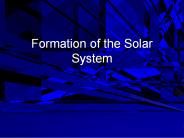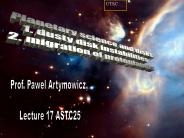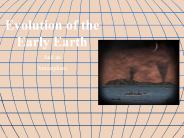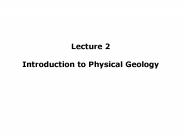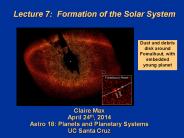Protoplanet PowerPoint PPT Presentations
All Time
Recommended
Lithosphere-The outer layer of Earth's structure made up of the crust and solid ... Asthenosphere-The layer below the lithosphere that is made up of the rest of the ...
| PowerPoint PPT presentation | free to view
Planetesimal: small body from which a planet originated in the development of the solar system. Some planetesimals fused together to form protoplanets. ...
| PowerPoint PPT presentation | free to view
The Solar System is highly differentiated ... More material in the outer solar system allowed four large protoplanets to form ...
| PowerPoint PPT presentation | free to view
The four protoplanets that became Mercury, Venus, Earth, and Mars were close to the sun. ... The next four protoplanets became Jupiter, Saturn, Uranus, and Neptune. ...
| PowerPoint PPT presentation | free to view
Planetesimals in the early solar system collide and accrete to form protoplanets. ... Planetesimal: small ~1km rocky asteroid-like objects in early solar system ...
| PowerPoint PPT presentation | free to view
Runaway growth in the Asteroid belt in the presence of Jupiter ... Giant impact phase. A few tens of mars-size protoplanets form after the runaway phase ...
| PowerPoint PPT presentation | free to view
Long term evolution of circumstellar discs: DM Tau and GM Aur Ricardo Hueso (*) & Tristan Guillot Laboratoire Cassini, Observatoire de la C te d Azur, Nice, France
| PowerPoint PPT presentation | free to download
Origin of Our Solar System TEK Objective 5: Earth in space and time. The student understands the solar nebular accretionary disk model. The student is expected to ...
| PowerPoint PPT presentation | free to view
Formation of the Solar System ... * The big bang spread matter throughout the expanding universe. Some of this matter gathered into clouds of dust and gas.
| PowerPoint PPT presentation | free to download
Structure of the Sun and Solar Activity Structure of the Sun and Solar Activity The Inner Zone a. Radiative zone. Energy moves to the outside by Electromagnetic ...
| PowerPoint PPT presentation | free to view
Skenario Kehancuran Kehidupan Bumi dan Alam Semesta QS 21:30-- 13,7 M tahun lalu Bigbang Asal Alam semesta Bigbang diyakini dari cosmic background ...
| PowerPoint PPT presentation | free to view
Extrasolar Planets The first planet detected ... Rules of chemistry Observations of rock ... Asteroids Some asteroids appear to be rubble piles of broken ...
| PowerPoint PPT presentation | free to view
Great Migrations & other natural history tales ... utsc
| PowerPoint PPT presentation | free to download
The Origin of Earth Six facts must be considered when formulating a hypothesis about the origin of Earth: Planets revolve around the sun in the same direction.
| PowerPoint PPT presentation | free to download
... Planet Formation. Hilke Schlichting. Advisor: Re em Sari. Planet ... 2-body Problem. Conservation of Energy & Momentum. Integration over b. Fdf=2pSGM. b. M ...
| PowerPoint PPT presentation | free to view
Title: PowerPoint Presentation Author: Stacy - McGraw-Hill Higher Education Last modified by: greg Created Date: 6/16/2003 2:59:31 PM Document presentation format
| PowerPoint PPT presentation | free to download
Comparative Planetology II: The Origin of Our Solar System
| PowerPoint PPT presentation | free to view
Planetesimals outside the snow line became eccentric ... Density of solids: divide mass of region by total N, or fix planetesimal mass at 0.01M ...
| PowerPoint PPT presentation | free to download
Title: Chapter 27 Stars and Galaxies Author: Tom Tweardy Last modified by: Staff Created Date: 4/30/2006 10:18:17 PM Document presentation format
| PowerPoint PPT presentation | free to download
Three orders of magnitude in distance. Nine orders of magnitude in volume! ... orders of magnitude in distance. Nine orders of magnitude in volume! (Grundy ...
| PowerPoint PPT presentation | free to download
The interaction of a giant planet with a disc with MHD turbulence II: The interaction of the planet with the disc Papaloizou & Nelson 2003, MNRAS 339 (4), 993
| PowerPoint PPT presentation | free to download
comets. Larger planetesimals attract smaller ones (gravity) ... comets collide with terrestrial planets. Deposit volatiles ... of comets (volatile ...
| PowerPoint PPT presentation | free to view
Refraction of seismic waves. Density of the entire planet. Gravity (mass) of entire planet ... Earth: The Unfinished Planet. Earth continues to lose heat ...
| PowerPoint PPT presentation | free to download
0 The Origin of the Solar System Planetary Orbits Neptune Uranus Saturn Jupiter Mars Earth Venus Mercury All planets in almost circular (elliptical) orbits around the ...
| PowerPoint PPT presentation | free to download
In a dense molecular cloud far, far away proposed originally by Kant, Laplace, and others in the 1700's solar system formed from a nebula (cloud of interstellar gas ...
| PowerPoint PPT presentation | free to view
The universe began as hot, dense matter that was concentrated into a ... English scientist Sir Isaac Newton explained why planets stay in orbit (17th century) ...
| PowerPoint PPT presentation | free to view
The Origin of Our Solar System Chapter Eight Introduction To Modern Astronomy I: Solar System Constrains of Models Any theoretical model must be able to explain the ...
| PowerPoint PPT presentation | free to download
belajar tentang solar system
| PowerPoint PPT presentation | free to download
Geologic Time and Origins of the Earth Thinking about time Geologic time vs. normal time What is the date today? What is the day? What is the time?
| PowerPoint PPT presentation | free to view
non-redundant masking on JWST TFI Anand Sivaramakrishnan STScI JWST TFI Science Team (NRM lead) Stony Brook Physics & Astronomy JAM team lead (JWST Aperture masking ...
| PowerPoint PPT presentation | free to view
... that more massive Jupiter and Saturn attracted much of the gas ... of Saturn - NASA ... nasa.gov/photo_gallery/photogallery-saturn.html#satellites ...
| PowerPoint PPT presentation | free to download
Formation of the Solar System Solar System Formation of the Solar System preview of the big bang theory the interstellar medium nebular condensation theories what s ...
| PowerPoint PPT presentation | free to download
Migration occurs by tidal interaction between planet and disk: ... Migration of a Jovian planet over 10 Myr. Note extent of gap opened by planet once inside dead zone. ...
| PowerPoint PPT presentation | free to download
* Moons Pandora and Prometheus ... 1994 Jupiter is orbited by four large moons and tens of small ones Io s surface is sculpted by volcanic activity Io s ...
| PowerPoint PPT presentation | free to view
Protoplanetary disks are thought to be the progenitors of planetary systems. ... If tidal torques dominate, a large annular gap in the disk opens up around the ...
| PowerPoint PPT presentation | free to download
Keynote speaker: Ann Grandfield, program manager for the Dawn spacecraft at ... Dawn's mission to investigate Ceres and Vesta, two of the largest and oldest asteroids. ...
| PowerPoint PPT presentation | free to view
What is the subject of the act 'Formation and evolution of OUR Jovian planets' ... Strong disequilibrium phases can be anyhow possible (Wuchterl, 1993), and shock ...
| PowerPoint PPT presentation | free to view
Planetas extrasolares e nuvens moleculares Horacio Dottori Dpto. Astronomia IF-UFRGS SETI (Vida vs. Vida Inteligente) Como podemos comprobar en la propia Tierra, hay ...
| PowerPoint PPT presentation | free to download
Hot near center, cooler further away. material can condensate if cool enough ... now mostly look for wobble of Star (Doppler shift) due to gravity of planets ...
| PowerPoint PPT presentation | free to view
To Guide the Habitable Planet Search (TPF, Darwin), we Need to Know: ... Most of Earth's water was accreted during formation from bodies past snow line ...
| PowerPoint PPT presentation | free to view
Accretion of Planets Bill Hartmann Star & Planet Formation Minicourse, U of T Astronomy Dept. Lecture 5 - Ed Thommes Overview Start with planetesimals: km-size bodies ...
| PowerPoint PPT presentation | free to download
What is a Planet? Physical Geology (1) A 'planet'1 is a celestial body that (a) is in orbit around the Sun, (b) has ... body forces so that it assumes a ...
| PowerPoint PPT presentation | free to download
To guide the Habitable Planet Search (TPF, Darwin), we need to know: ... Most of Earth's water was accreted during formation from bodies past snow line ...
| PowerPoint PPT presentation | free to view
ALMA Science Examples Min S. Yun (UMass/ANASAC)
| PowerPoint PPT presentation | free to download
Geophysics/Tectonics Brief Review of the Universe GLY 325
| PowerPoint PPT presentation | free to download
Title: The Milky Way Author: Markus Boettcher Last modified by: roberts Created Date: 2/23/2003 4:28:17 AM Document presentation format: On-screen Show
| PowerPoint PPT presentation | free to download
Title: Planetas extrasolares e vida extraterrestre Last modified by: Dr. Dottori Document presentation format: Presentaci n en pantalla Other titles
| PowerPoint PPT presentation | free to download
Photosphere (innermost layer of the atmosphere) ... dark areas of gas within the photosphere that are caused by powerful magnetic fields ...
| PowerPoint PPT presentation | free to view
Callisto wears the scars of a huge asteroid impact ... Titan is Saturn's largest moon ... Neptune's largest moon, Tritan, was probably captured by Neptune's gravity ...
| PowerPoint PPT presentation | free to view
Terdapat aktivitas vulkanisme (intrusi & ekstrusi) Merupakan daerah hiposentra gempa dangkal dan dalam Lempeng dasar samudera menujam ke bawah lempeng benua (zona ...
| PowerPoint PPT presentation | free to view
Universe. Eighth Edition. Roger A. Freedman William J. Kaufmann III. CHAPTER 8 ... Its believed that some of the heavier elements was once inside other stars. ...
| PowerPoint PPT presentation | free to view
Title: Building the Terrestrial Planets: Constraining Accretion in the Inner Solar System Author: MacP91 LASP Last modified by: Sean Raymond Created Date
| PowerPoint PPT presentation | free to download
Chapter 1 Introduction to Planet Earth Essentials of Oceanography 7th Edition * * Geography of the oceans Earth s oceans: Cover 70.8% of Earth s surface Are ...
| PowerPoint PPT presentation | free to view
The planets, satellites, comets, asteroids, and the Sun itself formed from the ... Did all of the planets form in the same way? Are there planets orbiting other stars? ...
| PowerPoint PPT presentation | free to download
What caused the orderly patterns of motion in our solar system? ... birth region of planets Dust is continuously replenished by disruptive collisions between ...
| PowerPoint PPT presentation | free to download
CHAPTER 1 Introduction to Planet Earth Overview 70.8% Earth covered by ocean Interconnected global or world ocean ...
| PowerPoint PPT presentation | free to download









